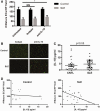Interleukin 10 hampers endothelial cell differentiation and enhances the effects of interferon α on lupus endothelial cell progenitors
- PMID: 25416712
- PMCID: PMC4447841
- DOI: 10.1093/rheumatology/keu431
Interleukin 10 hampers endothelial cell differentiation and enhances the effects of interferon α on lupus endothelial cell progenitors
Abstract
Objective: SLE is an autoimmune disease characterized by autoantibody generation, organ damage and an increased risk of cardiovascular disease. Generally considered an anti-inflammatory cytokine, IL-10 is increased in SLE and correlates with poor cardiovascular outcomes in the general population. The aim of this study was to explore the putative role of IL-10 in modulating endothelial function in SLE by examining the effects of this cytokine on endothelial progenitor cell/circulating angiogenic cell (EPC/CAC) differentiation.
Methods: Human and murine control and lupus EPCs/CACs were differentiated into mature endothelial cells (ECs) in the presence or absence of graded concentrations of recombinant IL-10 with or without recombinant IFN-α or a neutralizing antibody to IL-10. IL-10-deficient mice were examined to assess the role of this cytokine in type I IFN-mediated inhibition of EC differentiation and neo-angiogenesis using an in vivo Matrigel plug assay. Serum IL-10 concentrations were measured via ELISA.
Results: IL-10 hampers EC differentiation in a dose-dependent manner. In murine EPC cultures, IL-10 is required to observe the inhibitory effects of type I IFNs on EPC function and neo-angiogenesis. In human SLE EPC/CAC cultures, neutralization of IL-10 significantly improved the differentiation of EPCs, and IL-10 enhanced type I IFN-mediated EPC/CAC dysfunction. The presence of IL-10 in serum inversely correlated with EPC/CAC function in SLE but not in control cells.
Conclusion: IL-10 interferes with endothelial differentiation and may enhance the effects of type I IFN on vascular repair in SLE. IL-10 may be a relevant target for improving cardiovascular risk in SLE.
Keywords: IL-10; cardiovascular; endothelial progenitor; interferon α; lupus.
© The Author 2014. Published by Oxford University Press on behalf of the British Society for Rheumatology. All rights reserved. For Permissions, please email: journals.permissions@oup.com.
Figures





References
-
- Manzi S, Meilahn EN, Rairie JE, et al. Age-specific incidence rates of myocardial infarction and angina in women with systemic lupus erythematosus: comparison with the Framingham Study. Am J Epidemiol. 1997;145:408–15. - PubMed
-
- Briasoulis A, Tousoulis D, Antoniades C, Papageorgiou N, Stefanadis C. The role of endothelial progenitor cells in vascular repair after arterial injury and atherosclerotic plaque development. Cardiovasc Ther. 2011;29:125–39. - PubMed
-
- Vasa M, Fichtlscherer S, Aicher A, et al. Number and migratory activity of circulating endothelial progenitor cells inversely correlate with risk factors for coronary artery disease. Circ Res. 2001;89:E1–7. - PubMed
Publication types
MeSH terms
Substances
Grants and funding
LinkOut - more resources
Full Text Sources
Other Literature Sources
Medical

